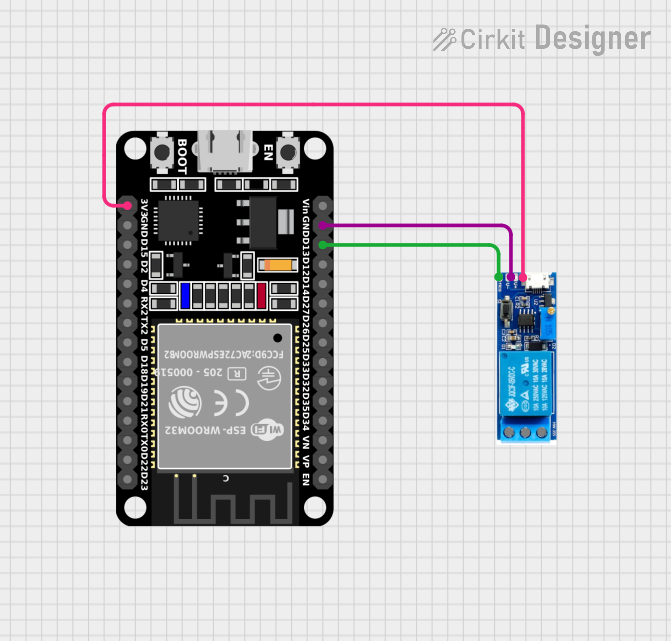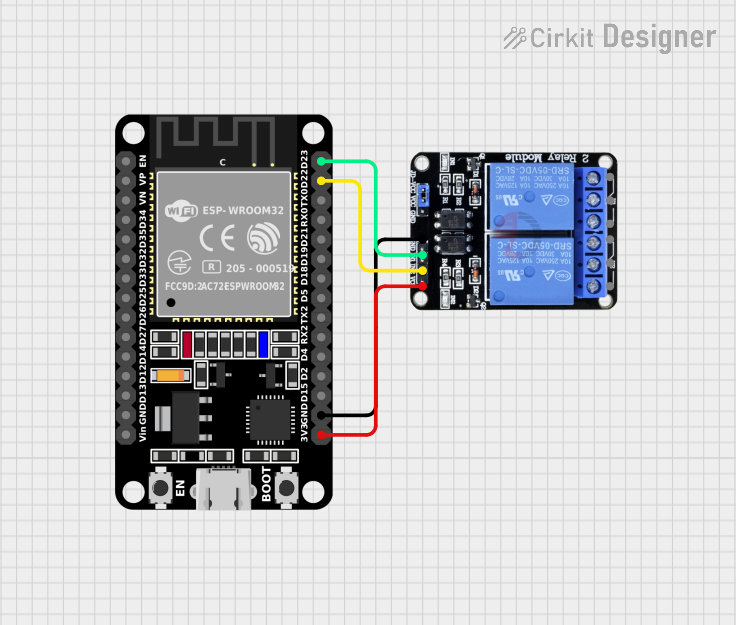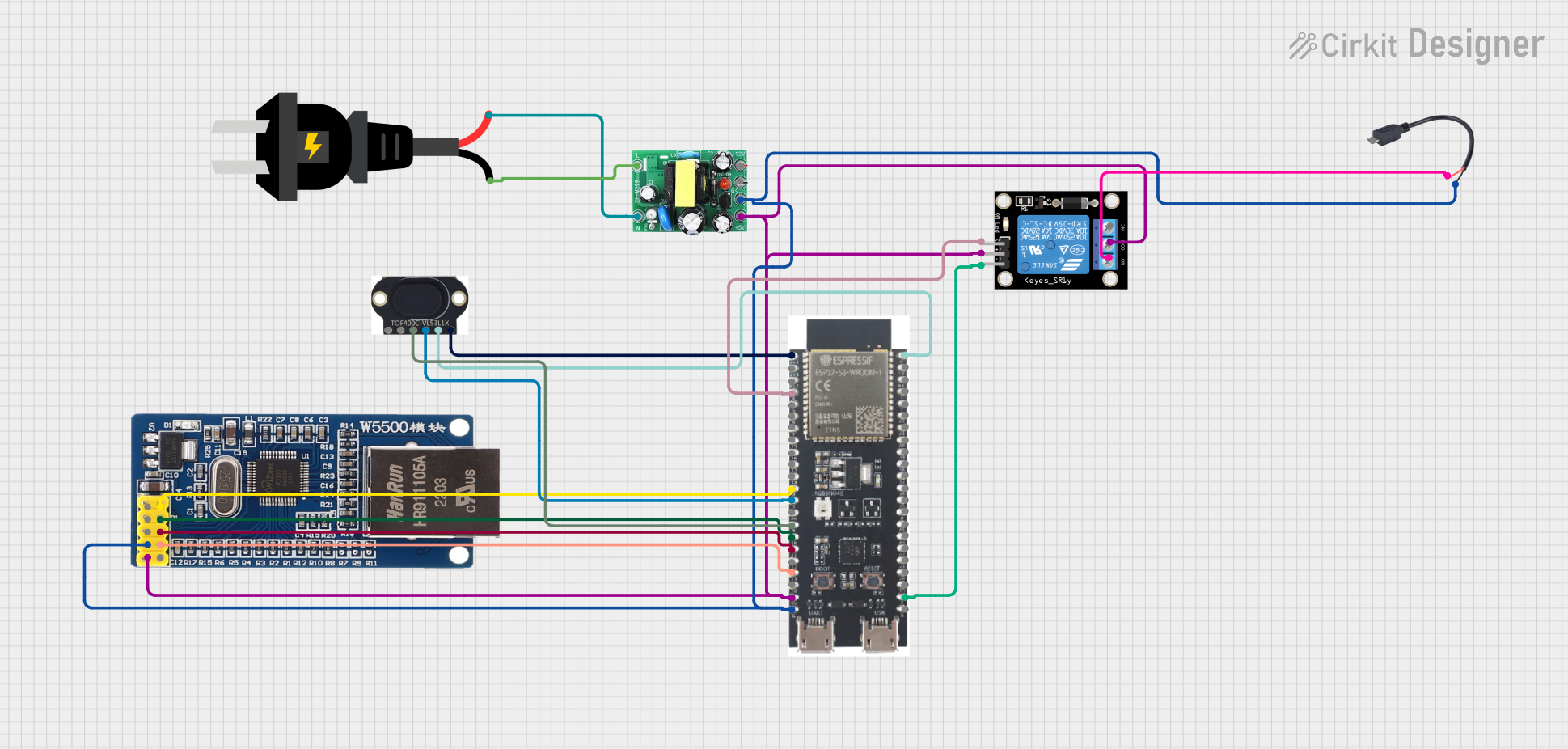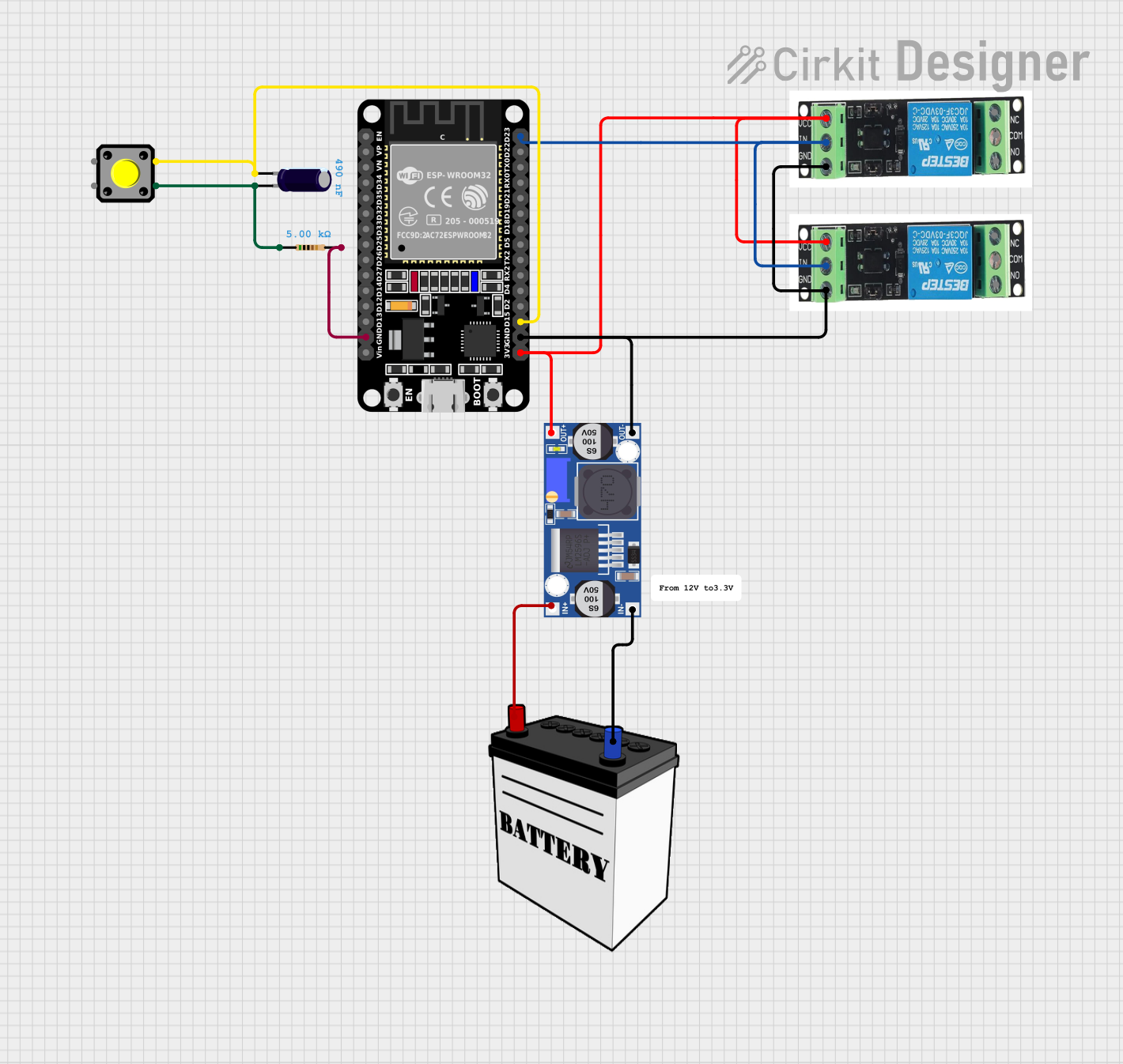
How to Use Relay 3.3v: Examples, Pinouts, and Specs

 Design with Relay 3.3v in Cirkit Designer
Design with Relay 3.3v in Cirkit DesignerIntroduction
A Relay 3.3V is an electromechanical switch that uses a low voltage (3.3V) control signal to open or close a circuit. This allows for the control of higher voltage or high-current devices, such as motors, lights, or appliances, using a low-power control signal. Relays are widely used in automation, home appliances, and industrial control systems due to their ability to isolate the control circuit from the high-power circuit.
Explore Projects Built with Relay 3.3v

 Open Project in Cirkit Designer
Open Project in Cirkit Designer
 Open Project in Cirkit Designer
Open Project in Cirkit Designer
 Open Project in Cirkit Designer
Open Project in Cirkit Designer
 Open Project in Cirkit Designer
Open Project in Cirkit DesignerExplore Projects Built with Relay 3.3v

 Open Project in Cirkit Designer
Open Project in Cirkit Designer
 Open Project in Cirkit Designer
Open Project in Cirkit Designer
 Open Project in Cirkit Designer
Open Project in Cirkit Designer
 Open Project in Cirkit Designer
Open Project in Cirkit DesignerCommon Applications and Use Cases
- Home automation systems (e.g., controlling lights or fans)
- Industrial equipment control
- Motor control circuits
- Safety systems (e.g., emergency shutoff)
- IoT projects with microcontrollers like Arduino or Raspberry Pi
Technical Specifications
The following table outlines the key technical details of the Relay 3.3V:
| Parameter | Value |
|---|---|
| Control Voltage | 3.3V DC |
| Operating Current | ~70mA (coil current) |
| Switching Voltage | Up to 250V AC / 30V DC |
| Switching Current | Up to 10A |
| Contact Type | SPDT (Single Pole Double Throw) or SPST (Single Pole Single Throw) |
| Isolation | Electrical isolation between control and load circuits |
| Coil Resistance | ~45Ω |
| Operating Temperature | -40°C to 85°C |
| Dimensions | Varies by model (e.g., 28mm x 12mm x 10mm) |
Pin Configuration and Descriptions
The Relay 3.3V typically has 5 pins. The table below describes each pin:
| Pin Name | Description |
|---|---|
| VCC | Connects to the 3.3V power supply to energize the relay coil. |
| GND | Ground connection for the relay coil. |
| IN (Control) | Control signal input (3.3V logic HIGH activates the relay). |
| COM (Common) | Common terminal for the load circuit. |
| NO (Normally Open) | Load terminal that remains disconnected until the relay is activated. |
| NC (Normally Closed) | Load terminal that remains connected until the relay is activated. |
Usage Instructions
How to Use the Relay 3.3V in a Circuit
- Power the Relay: Connect the VCC pin to a 3.3V power source and the GND pin to ground.
- Control Signal: Connect the IN pin to a microcontroller or other control circuit capable of providing a 3.3V signal.
- Load Circuit:
- Connect the load device (e.g., a light bulb or motor) to the COM and NO pins if you want the load to turn on when the relay is activated.
- Alternatively, connect the load to the COM and NC pins if you want the load to turn off when the relay is activated.
- Isolation: Ensure proper electrical isolation between the control and load circuits to prevent damage to the control circuit.
Important Considerations and Best Practices
- Flyback Diode: Always use a flyback diode across the relay coil to protect the control circuit from voltage spikes caused by the collapsing magnetic field when the relay is deactivated.
- Current Rating: Ensure the load current does not exceed the relay's maximum switching current (10A).
- Power Supply: Use a stable 3.3V power supply to avoid erratic relay behavior.
- Microcontroller Compatibility: If using a microcontroller like Arduino, ensure the control pin can source enough current (~70mA) or use a transistor to drive the relay.
Example: Connecting to an Arduino UNO
Below is an example of how to connect and control a Relay 3.3V using an Arduino UNO:
Circuit Diagram
- Connect the relay's VCC pin to the Arduino's 3.3V pin.
- Connect the relay's GND pin to the Arduino's GND pin.
- Connect the relay's IN pin to Arduino digital pin 7.
- Connect the load (e.g., a light bulb) to the COM and NO pins of the relay.
Arduino Code
// Define the relay control pin
const int relayPin = 7;
void setup() {
// Set the relay pin as an output
pinMode(relayPin, OUTPUT);
// Ensure the relay is off at startup
digitalWrite(relayPin, LOW);
}
void loop() {
// Turn the relay on (activate)
digitalWrite(relayPin, HIGH);
delay(5000); // Keep the relay on for 5 seconds
// Turn the relay off (deactivate)
digitalWrite(relayPin, LOW);
delay(5000); // Keep the relay off for 5 seconds
}
Troubleshooting and FAQs
Common Issues and Solutions
Relay Not Activating:
- Cause: Insufficient control voltage or current.
- Solution: Ensure the control signal is 3.3V and the source can supply at least 70mA. Use a transistor if needed.
Load Not Switching:
- Cause: Incorrect wiring of the load circuit.
- Solution: Verify the load is connected to the correct relay terminals (COM and NO/NC).
Relay Clicking Rapidly:
- Cause: Unstable control signal or power supply.
- Solution: Use a stable 3.3V power source and check for noise in the control signal.
Microcontroller Resetting:
- Cause: Voltage spikes from the relay coil.
- Solution: Add a flyback diode across the relay coil.
FAQs
Q: Can I use the Relay 3.3V with a 5V control signal?
A: No, the relay is designed for a 3.3V control signal. Using a 5V signal may damage the relay or cause erratic behavior.
Q: Can the Relay 3.3V switch both AC and DC loads?
A: Yes, the relay can switch AC loads up to 250V and DC loads up to 30V, provided the current does not exceed 10A.
Q: Do I need a separate power supply for the relay?
A: If your control circuit (e.g., Arduino) can provide a stable 3.3V and sufficient current, a separate power supply is not necessary. Otherwise, use an external 3.3V power source.
Q: How do I know if the relay is activated?
A: Many relays include an onboard LED that lights up when the relay is activated. Alternatively, you can measure continuity between the COM and NO pins.